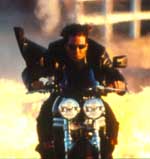
Mission: Impossible 2 is a fairly expert piece of star packaging, which is not necessarily the same thing as a good movie. Directed by John Woo and written by Robert Towne, it sets itself off from Brian De Palma’s Mission: Impossible by serving up its luminary, Tom Cruise, as an adventurer with soul. His Ethan Hunt is no longer just a guy who lives by his stopwatch and swoops down from high places tethered to cable ropes; he’s also a man in love. You can tell this because his gaze has a wall-eyed burn and his longish hair streams poetically, especially when he’s buzzing in his motorbike around dead man’s curves. This guy cares. The object of his caring, Nyah Hall (Thandie Newton), is a thief-turned-mission-impossiblist, and she’s all dreamy, enigmatic smiles and melancholia – a swoon in motion. “I’m not going to lose you!” Ethan informs her during one particularly dicey moment in the action, but it’s not clear when exactly he ever had her. For all the deep yearning on display, for all the slo-mo shampoo-commercial-style sensuality, their love match isn’t really on a much higher level than what usually goes on between 007 and his Bond Girl. Ethan will surely get over her. Wanna bet Nyah’s a no-show in M:I-3?
The Bond reference is apt because so much of this film, even more than its predecessor, is patterned on the prefab tropes of that series. I guess no mission is too impossible if you have the right template. Somehow, this sort of patterning works better when Mike Myers is running the show; Austin Powers is a much more entertaining pseudo-Bond than Ethan, and, given Ethan’s boring predilection for basic black, Austin’s a better dresser too. The villains aren’t quite up to snuff, either. Sean Ambrose (Dougray Scott) is a standard-issue scowler whose gnarliest moment comes when he slices off the tip of his henchman’s finger with a cigar cutter. Depravity, where is thy sting? Ernst Blofeld would have had this guy for lunch. Ambrose’s scheme is to launch a deadly virus into the world and then market its antidote, thereby reaping billions. It’s not a bad scheme, actually, but badness of this caliber needs more panache. We are told several times in the movie that a hero is only as good as his villain, but the filmmakers haven’t taken their own counsel.
Which means that Tom Cruise, who also produced the movie, is pretty much the whole show. He has his usual all-business intensity (he even does most of his own stunt work), but despite Cruise’s attempts here to be Byronic, there’s something strenuous about his soulfulness; he turns everything, even repose, into calisthenics. It’s not enough that he’s a great big movie star; he has to be taken as something more, the CEO of his own destiny. But this carefully calibrated new star vehicle of his, even though it will probably be a monster hit, doesn’t do him any real favors. He’s loosened up a bit as an actor in recent years – I’m thinking particularly of Jerry Maguire and Magnolia – and yet for all the flowing hair, his return to Ethan Hunt marks a return to stick-figure land. It’s possible to play pulp action heroes and still deliver a performance – Sean Connery, of course, did it – but that means giving yourself over to the stylishness of schlock, and Cruise is too humorless an actor for that.
John Woo indulges the humorlessness. When he made his Hong Kong pulp fantasias starring Chow Yun-Fat, the hyperviolent excessiveness was a source of wit. Woo doesn’t bring that same comic delirium to his American films (the closest he came was in Face/Off, which his new movie borrows from), but he’s retained the mythic-shmythic stuff – the slowed-down ceremoniousness of the fight scenes and the hero-villain dualisms and the doves winging into frame at crucial moments. It’s all a bit much to hang on this slender thread. Brian De Palma, who, like Woo, has had some smashing successes in the realms of pulp mythos, didn’t attempt to glorify Mission: Impossible when he took it on; although that first film was so carelessly plotted it might have been called Mission: Incomprehensible, it had a couple of set pieces that, taken simply as theater, were like buzz cuts to the brain. The action scenes in M:I-2 don’t have that charge; they’re woozier and yet more conventional, full of skidding U-turns and fireballs and explosions of splintered glass. The climactic kung-fu clobberfest between Ethan and Sean seems surprisingly tame after everything that came before, and it also pales in comparison with similar scenes in The Matrix, a movie that, ironically, was heavily influenced by Woo. And yet, for all the movie-star engineering and digitizing and Dolbyized kabooms, there’s something endearing about the way Woo finishes the movie with just two guys slugging it out. It’s Woo’s version of minimalism, and it’s not a bad way to go. Future franchisers of this series, take note.